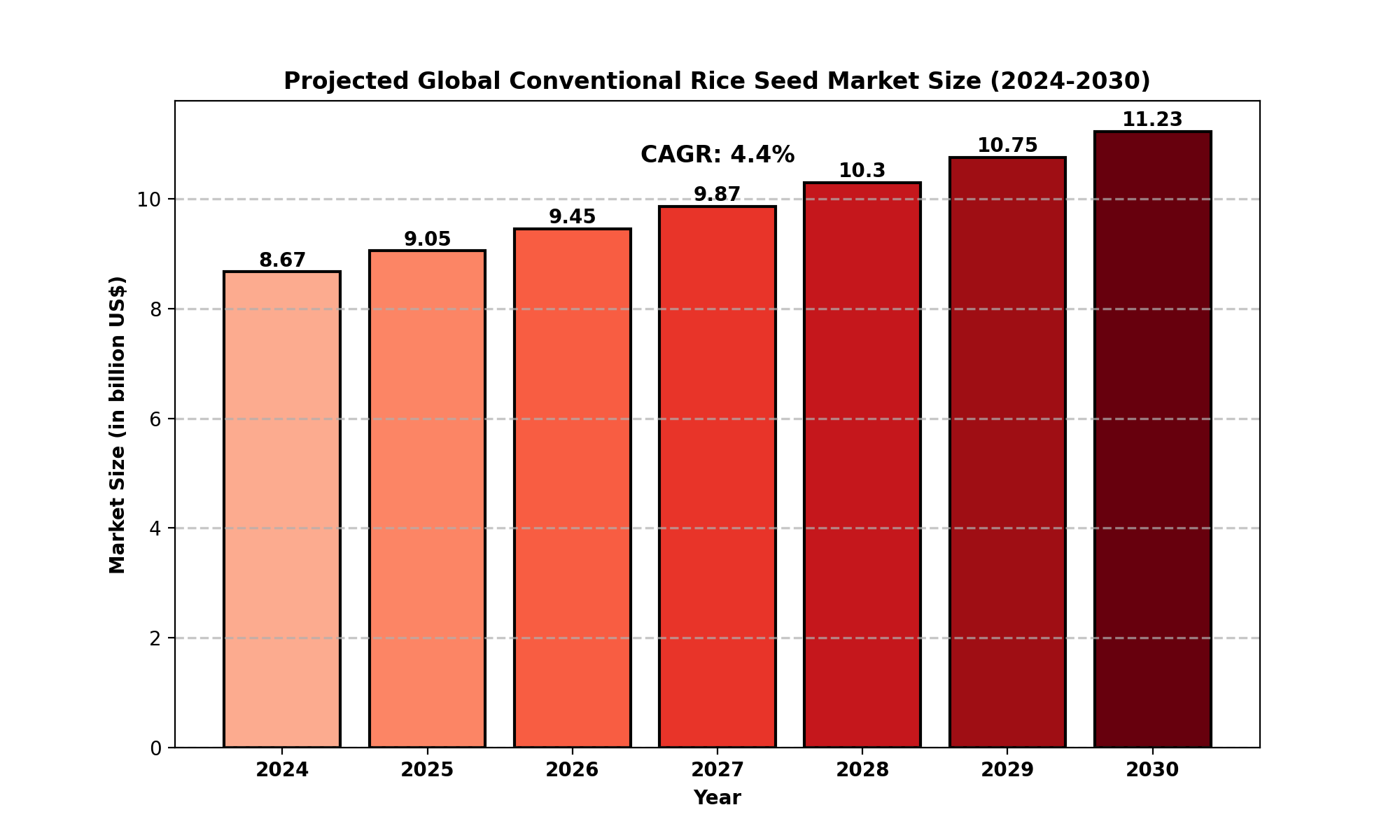TOP CATEGORY: Chemicals & Materials | Life Sciences | Banking & Finance | ICT Media

Download Report PDF Instantly
Report overview
Conventional Rice Seed refers to traditional, non-GMO rice varieties developed through conventional breeding methods for commercial cultivation. These seeds are selected for their yield, disease resistance, and adaptability to various climatic conditions. Unlike hybrid seeds, conventional rice seeds can be saved and replanted by farmers, making them a cost-effective option for agricultural production.
Market Size
The global Conventional Rice Seed market was valued at US$ 8.67 billion in 2024 and is projected to reach US$ 11.23 billion by 2030, growing at a CAGR of 4.4% during the forecast period. The United States market alone was valued at US$ 892.4 million in 2024, with expectations to reach US$ 1.12 billion by 2030, at a CAGR of 3.9%.
In 2023, the global production of conventional rice seeds reached 2.2 million metric tons, with long-grain varieties comprising 60% of the total demand. The medium-grain segment is experiencing a steady 4.8% annual growth rate, while hybrid varieties are increasing at 5.5% CAGR. Inbred varieties dominate with an 80% market share.

Market Dynamics
Drivers
Food Security Concerns: The rising global population and the need for stable food production drive demand for conventional rice seeds.
Sustainability and Traditional Farming: Many farmers prefer non-GMO, conventional seeds for their ability to be saved and replanted.
Government Support and Subsidies: Many governments worldwide support conventional rice farming through subsidies and incentives.
Increasing Demand for Disease-Resistant Varieties: The market saw a 12% increase in demand for disease-resistant conventional rice seeds in 2023.
Restraints
Lower Yield Compared to Hybrid Varieties: Conventional rice seeds often have lower yields than hybrid counterparts, impacting profitability.
Climate Change and Unpredictable Weather: Extreme weather conditions and natural disasters affect rice production and seed quality.
Limited R&D Funding Compared to Hybrid and GM Seeds: Most research investment focuses on hybrid and genetically modified varieties, limiting advancements in conventional rice seed development.
Opportunities
Expansion in Africa and Emerging Markets: Africa is the fastest-growing region in this market, with a CAGR of 5.8%.
Development of Stress-Tolerant Varieties: Investment in drought-resistant and flood-resistant conventional rice seeds has grown by 20% in R&D funding.
Growing Demand for Organic and Non-GMO Products: Consumers are increasingly seeking organic and non-GMO rice products, boosting demand for conventional rice seeds.
Challenges
Competition from Hybrid and GM Seeds: The market share of hybrid seeds is growing, making competition stiff for conventional varieties.
Pest and Disease Management: Conventional rice varieties require more intensive pest and disease management compared to hybrid counterparts.
Regional Analysis
Asia-Pacific (70% Market Share)
Asia-Pacific leads the global market, with major producers including China, India, Japan, and Southeast Asian countries. Long-grain and Japonica rice varieties dominate this region, and government programs support conventional rice seed adoption.
North America
The U.S. conventional rice seed market is valued at US$ 892.4 million (2024), with increasing demand from organic and non-GMO farming communities.
Europe
Europe is seeing growing demand, particularly in countries like France, Germany, and Italy, due to increased organic farming initiatives.
South America & Africa
Africa is the fastest-growing market, with a CAGR of 5.8%, driven by demand for drought-resistant rice varieties. Brazil and Argentina are major players in South America.
Competitor Analysis
Key Companies
Dupont Pioneer
Syngenta
Bayer CropScience
Nath Seeds
Advanta
Nirmal Seeds
Longping High-Tech
China National Seed Group
Hainan Shennong Gene
WIN-ALL HI-TECH SEED
Hefei Fengle Seed
Zhongnongfa Seed
Market Segmentation (by Type)
Indica Rice: Dominates global production, primarily grown in Asia.
Japonica Rice: High demand in Japan, Korea, and parts of China.
Glutinous Rice: Popular in Southeast Asian and specialty markets.
Market Segmentation (by Application)
Agricultural Production: Majority of conventional rice seed usage.
Scientific Research: Development of new, stress-tolerant rice varieties.
Geographic Segmentation
North America (USA, Canada, Mexico)
Europe (Germany, UK, France, Russia, Italy, Rest of Europe)
Asia-Pacific (China, Japan, South Korea, India, Southeast Asia, Rest of Asia-Pacific)
South America (Brazil, Argentina, Colombia, Rest of South America)
Middle East & Africa (Saudi Arabia, UAE, Egypt, Nigeria, South Africa, Rest of MEA)
FAQ Section
What is the current market size of the Conventional Rice Seed market?
Which are the key companies operating in the Conventional Rice Seed market?
What are the key growth drivers in the Conventional Rice Seed market?
Which regions dominate the Conventional Rice Seed market?
What are the emerging trends in the Conventional Rice Seed market?
Key Benefits of This Market Research:
Industry drivers, restraints, and opportunities covered in the study
Neutral perspective on the market performance
Recent industry trends and developments
Competitive landscape & strategies of key players
Potential & niche segments and regions exhibiting promising growth covered
Historical, current, and projected market size, in terms of value
In-depth analysis of the Conventional Rice Seed Market
Overview of the regional outlook of the Conventional Rice Seed Market:
Key Reasons to Buy this Report:
Access to date statistics compiled by our researchers. These provide you with historical and forecast data, which is analyzed to tell you why your market is set to change
This enables you to anticipate market changes to remain ahead of your competitors
You will be able to copy data from the Excel spreadsheet straight into your marketing plans, business presentations, or other strategic documents
The concise analysis, clear graph, and table format will enable you to pinpoint the information you require quickly
Provision of market value (USD Billion) data for each segment and sub-segment
Indicates the region and segment that is expected to witness the fastest growth as well as to dominate the market
Analysis by geography highlighting the consumption of the product/service in the region as well as indicating the factors that are affecting the market within each region
Competitive landscape which incorporates the market ranking of the major players, along with new service/product launches, partnerships, business expansions, and acquisitions in the past five years of companies profiled
Extensive company profiles comprising of company overview, company insights, product benchmarking, and SWOT analysis for the major market players
The current as well as the future market outlook of the industry concerning recent developments which involve growth opportunities and drivers as well as challenges and restraints of both emerging as well as developed regions
Includes in-depth analysis of the market from various perspectives through Porters five forces analysis
Provides insight into the market through Value Chain
Market dynamics scenario, along with growth opportunities of the market in the years to come
6-month post-sales analyst support
Customization of the Report
In case of any queries or customization requirements, please connect with our sales team, who will ensure that your requirements are met.